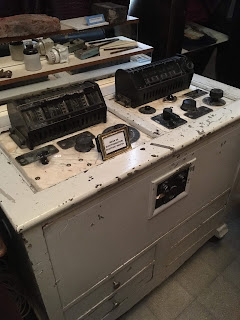Hi everyone! It’s Amanda and Brittney. We are both 4th year CBU Nursing Students on the International Nursing Experience to beautiful Buenos Aires, Argentina. We started off our day early this morning to get a bus to the Roffo hospital which is a cancer care and research centre. This is an amazing facility unlike anything offered in Nova Scotia. The campus has multiple buildings separated according to which type of cancer (lung, liver, skin, etc.) will be treated there, and in 2016 over 100,000 people were treated in this one location! The facility opened in 1912 by Roffo who was a oncologist and researcher. His wife, Helena, also opened the school of nursing at the facility which is still open today and takes in 60 students each year. His son is also the focus of one of Argentina’s most famous paintings called “2 big friends” which featured Roffo’s son and his St. Bernard (Amanda LOVED this). The hospital has 80 inpatient beds but also has countless outpatients each day which are treated through chemotherapy, radiation and immunotherapy.
Our second presentation, also at La Roffo) focused on the health system in Argentina which has 3 sectors. The first is public which everyone living in Argentina has equal access to for free (well, with taxes). Many people also travel from Bolivia and Peru to access Argentina’s health care at no cost. The second is social which would be similar to an employees health insurance in Canada such as Manulife where the employees pay cheque is deducted each month. The third option of private health insurance would be at a cost of about $600-700 US dollars per month for a family of 5 paid completely out of pocket. Private and social insurance give quicker access to certain treatments, appointments and medications that the public sector may have to wait a longer period of time for (up to a week for medications that are readily available in Canada). Much like our home there is a large shortage of health care staff in rural areas. So much so that some housekeeping staff are providing nursing care in some settings.
Next, after a very long, bumpy and smooshy ride on the bus we arrived at our next stop. A public hospital called general de Aguados Bernardino Rivadavia. This hospital was built in 1889 and it services many different illnesses, diseases and speciality (Eating disorders, ENT, gynecology, cardiology) as well as offering emergency care to 800-900 people a day with wait times of 20 minutes to 2 hours! We also saw the museum in the hospital which showed many of the instruments and supplies the hospital used in its early days. We were especially surprised by the obstetrical (birthing) instruments. While 10 of us went through the small museum at a time the other students had an impromptu NCLEX prep sessions administered by our fearless leaders Debbie, Belinda, Angela and Kim where we went over normal lab values, HELP syndrome, etc. We then had an in depth discussion about Argentinian vs. Canadian health care with the doctor and had a large focus on the reproductive rights of Argentinian women. They have a large issue of illegal abortion and women dying due to unsafe practices and being forced to deliver babies after situations of sexual assault and mental health issues. After a very informative group discussion we had a tour of the beautiful hospital grounds and back to the hostel we went for some much needed cold water and after-clinical relaxation before heading out to the streets to deliver donations to the homeless population in the city centre.
















No comments:
Post a Comment